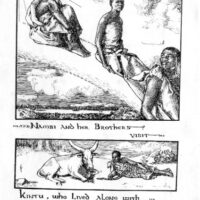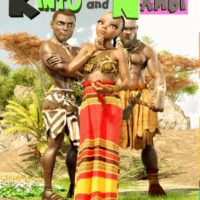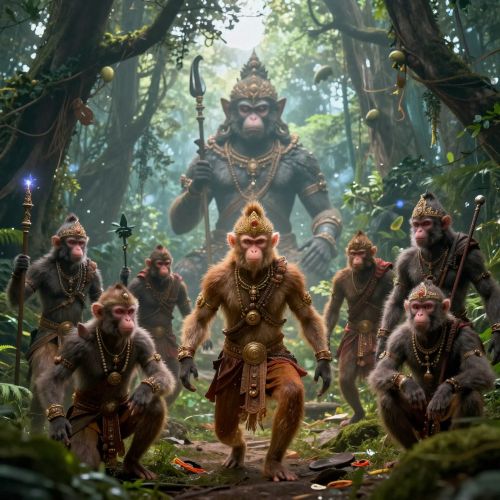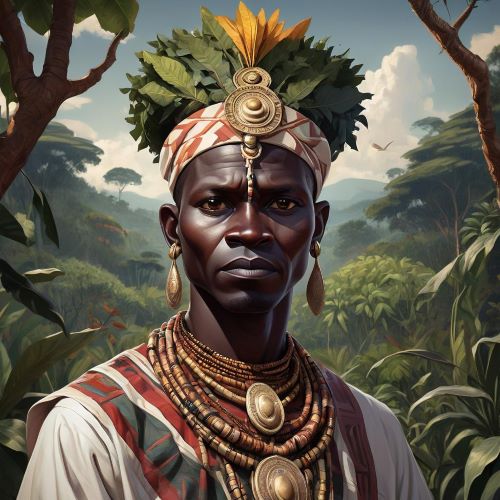Nambi : The First Woman
Listen
At a glance
| Description | |
|---|---|
| Origin | Baganda Mythology |
| Classification | Mortals |
| Family Members | Ugulu (Father), Kintu (Husband), Walumbe (Brother) |
| Region | Uganda |
| Associated With | Agriculture, Livestock |
Nambi
Introduction
Nambi holds a revered place in the mythology of the Baganda people of Uganda. As the daughter of Ggulu (also spelled Mugulu), the supreme sky god, she bridges the divine and mortal worlds in a tale that explains not just the origins of humanity, but also the presence of suffering and death. Her love story with Kintu, the first man on Earth, is at the heart of the Baganda creation myth. It is through her choices—both brave and tragic—that the foundations of civilization, agriculture, and even mortality are laid for future generations. Far from being a mere supporting character in myth, Nambi is remembered as a wise, strong, and deeply influential figure whose decisions shaped the destiny of humankind.
Physical Traits
Traditional oral accounts do not dwell heavily on Nambi’s physical form, focusing more on her actions and symbolism. However, she is widely imagined as possessing otherworldly beauty that reflects her celestial origins. Her grace and nurturing qualities align her with fertility and life-giving powers, reinforcing her image as a divine being of light and abundance.
Modern adaptations, such as the 2023 Ugandan short film Nambi, have taken creative liberties to bring her image to life. She is often portrayed with radiant skin, green eyes, and adorned in golden jewelry—visual cues meant to contrast her heavenly stature with the simplicity of Kintu, the earthly man she chooses to love. These portrayals emphasize her divine lineage while also helping new generations visualize her myth in a relatable way.
Family
Nambi comes from a powerful celestial family. Her father, Ggulu, is the ruler of the sky realm and creator of many beings. Among her siblings are Walumbe, associated with death and suffering, and Kayikuzi, a divine warrior. While her relationship with Kintu is central to her story, it’s the tension within her family—particularly with Walumbe—that gives her tale its tragic weight.
When Nambi chooses to descend to Earth with Kintu, she is warned not to return to the heavens for any forgotten items. But when she returns for millet, she is unknowingly followed by her brother Walumbe. His descent marks the beginning of mortality for humanity, a sorrowful contrast to Nambi’s original hope for a harmonious life on Earth. The dynamic between Nambi, her father, and her brothers offers rich insight into the Baganda worldview, where cosmic balance and familial duty intersect with the everyday human experience.
Other names
Although most stories refer to her simply as Nambi, variations in regional dialects and oral tradition sometimes link her more closely to her divine origin, referring to her as “Nambi, daughter of Ggulu” or “Mugulu’s daughter.” These identifiers emphasize her celestial lineage, a key part of her mythic identity.
In modern retellings, particularly those that merge myth with media, the name “Nambi” itself has taken on iconic status. The 2023 film of the same name exemplifies how a traditional figure can transcend myth to become a cultural symbol for identity, resilience, and heritage.
Powers and Abilities
Nambi’s influence in the myth does not come from physical prowess or overt magical acts, but from her ability to shape destiny through her decisions. As a divine being, she can move between realms—sky and Earth—which symbolizes her role as a bridge between the gods and humanity.
One of her most important contributions to the human world is the introduction of agriculture. By bringing livestock and seeds from the sky realm, she equips early humans with the tools necessary for survival and prosperity. Her foresight, generosity, and nurturing nature are seen as divine gifts bestowed upon mankind. However, her tragic return to the heavens to retrieve forgotten millet, against her father’s warning, underscores the limits of foresight—even for a goddess. It introduces a profound lesson on the irreversible consequences of even well-intentioned actions.
Modern Day Influence
Nambi’s legend continues to resonate deeply within Ugandan society. Her story is not just an origin myth—it serves as a cultural framework for understanding life, love, responsibility, and mortality. As Ugandans pass her story from generation to generation, Nambi becomes more than a mythological figure; she is a moral compass and cultural touchstone.
Her influence extends into various forms of modern expression. In literature, her character is explored for its emotional and symbolic depth. In the performing arts, traditional dances and plays often include her story as a key narrative arc. And in visual media, the story of Nambi has found new life. The film Nambi brought together traditional themes and cutting-edge animation to retell her myth for a contemporary audience, highlighting the enduring power of African storytelling.
Educational institutions also use her narrative to teach moral values, critical thinking, and an appreciation for Uganda’s rich mythological heritage. Festivals celebrating traditional culture often include dramatizations of Nambi’s story, ensuring that her legacy remains vibrant and accessible. Furthermore, Nambi’s role as a cultural symbol has made her a point of pride in discussions on gender, heritage, and national identity. As Uganda continues to modernize, stories like hers remind citizens of their deep cultural roots and the timeless wisdom held in myth.
Related Images
Source
Dagiz Travel. (2025, February 11). Folklore and storytelling in Ugandan communities. https://www.dagiztravel.com/africa/uganda_culture/fairytales_and_storytelling
Fallers, L. A. (1964). The King’s Men: Leadership and Status in Buganda on the Eve of Independence. Oxford University Press. https://www.worldcat.org/title/kings-men-leadership-and-status-in-buganda-on-the-eve-of-independence/oclc/893941786
Kizza, I. N. (n.d.). The oral tradition of the Baganda of Uganda. https://www.academia.edu/12345678/The_Oral_Tradition_of_the_Baganda_of_Uganda
Nannyonga-Tamusuza, S. A. (n.d.). Baakisimba: Gender in the music and dance of the Baganda people of Uganda. https://scholarworks.iu.edu/dspace/bitstream/handle/2022/25367/Nannyonga-Tamusuza.pdf
Otiso, K. (n.d.). Cultures and customs of Uganda. Greenwood Press.
PSM Charity. (2023, November 14). Nambi and Kintu: A love story above all. https://psmcharity.org/nambi-kintu-love-story
Uganda People and Culture. (2013). Nambi. Uganda Heritage Tales and Trails. https://ugandaheritage.go.ug/stories/nambi
Wikipedia contributors. (n.d.). Nambi (mythology). Wikipedia. https://en.wikipedia.org/wiki/Nambi_(mythology)
Frequently Asked Questions
What is lorem Ipsum?
I am text block. Click edit button to change this text. Lorem ipsum dolor sit amet, consectetur adipiscing elit. Ut elit tellus, luctus nec ullamcorper mattis, pulvinar dapibus leo.
What is lorem Ipsum?
I am text block. Click edit button to change this text. Lorem ipsum dolor sit amet, consectetur adipiscing elit. Ut elit tellus, luctus nec ullamcorper mattis, pulvinar dapibus leo.
What is lorem Ipsum?
I am text block. Click edit button to change this text. Lorem ipsum dolor sit amet, consectetur adipiscing elit. Ut elit tellus, luctus nec ullamcorper mattis, pulvinar dapibus leo.
What is lorem Ipsum?
I am text block. Click edit button to change this text. Lorem ipsum dolor sit amet, consectetur adipiscing elit. Ut elit tellus, luctus nec ullamcorper mattis, pulvinar dapibus leo.
What is lorem Ipsum?
I am text block. Click edit button to change this text. Lorem ipsum dolor sit amet, consectetur adipiscing elit. Ut elit tellus, luctus nec ullamcorper mattis, pulvinar dapibus leo.









